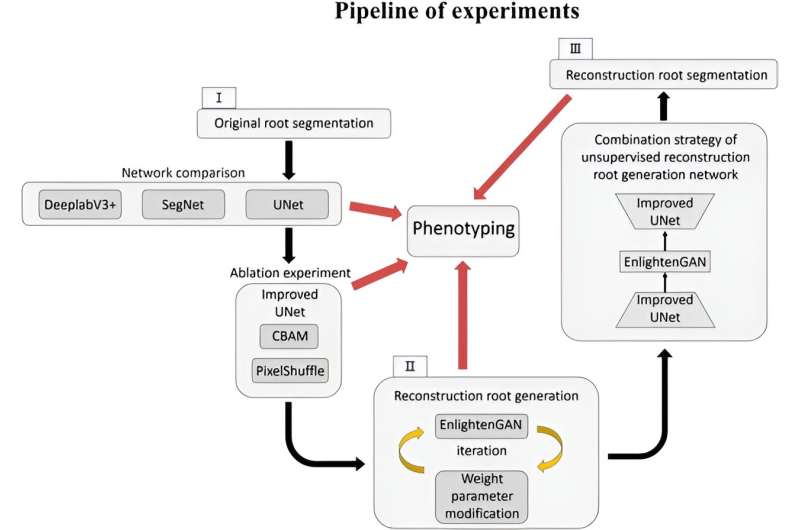This article has been reviewed according to Science X's editorial process and policies. Editors have highlighted the following attributes while ensuring the content's credibility:
fact-checked
trusted source
proofread
Harnessing AI for non-destructive in situ root imaging and phenotyping

Roots are essential for plant growth, but traditional methods of studying roots are resource-intensive and damaging. With advancements in image processing techniques, innovative methods for in situ root studies have emerged, providing non-destructive root imaging.
However, soil shading in images is the current challenge, which leads to fragmented root systems and a loss of structural integrity. And this fragmentation hampers the accurate assessment of root phenotypes. Although deep learning approaches such as SegRoot and ChronoRoot have enhanced root image recognition, issues like root breakage and soil coverage still remain.
Advancements in image restoration, particularly in situ root identification, are crucial for accurate root phenotype assessment. Techniques such as with techniques like generative adversarial networks (GANs) show potential in this part, but still require refinement.
In July 2023, Plant Phenomics published a research article titled "Application of Improved UNet and EnlightenGAN for Segmentation and Reconstruction of in Situ Roots." In this study, researchers proposed using EnlightenGAN for root reconstruction by manipulating the light intensity in targeted areas.
The team previously developed the RhizoPot platform, which can nondestructively collect the complete root images. Early stages showed accurate segmentation of roots with DeeplabV3+. However, there were inaccuracies in the analysis of root diameter and surface area. Continuous research has improved the accuracy of in situ root segmentation, but small pieces covered by soil still remain unidentified.
Comparing deep-learning models UNet, SegNet, and DeeplabV3+ on an original root dataset, the study found that DeeplabV3+ (Xception) had the best overall performance. However, each model had its strengths and weaknesses in root identification. Ablation experiments with various improvements on UNet showed increased performance in both mIOU and F1 scores, suggesting that these modifications successfully addressed the limitations of the models.
Transfer learning with the improved UNet on the reconstructed root dataset demonstrates good versatility and robustness. EnlightenGAN was used for root generation, with each iteration progressively enhancing root reconstruction. Phenotypic parameters were analyzed using RhizoVision Explorer software, which revealed a significant correlation with actual values. However, the reconstructed roots resulted in changes to root length and surface area.
The study conducted a thorough model comparison, highlighting the DeeplabV3+'s capabilities, but also noted the limitations of the model in recognizing main roots. The improved UNet was selected for root segmentation because of its scalability and potential for future enhancements. Finally, the study proposed various combinations of UNet and EnlightenGAN for different purposes, ranging from accurate segmentation to dataset expansion and unsupervised training.
Overall, the study demonstrates a significant advance in root reconstruction technology, offering a novel approach to root phenotyping analysis.
More information: Qiushi Yu et al, Application of Improved UNet and EnglightenGAN for Segmentation and Reconstruction of In Situ Roots, Plant Phenomics (2023). DOI: 10.34133/plantphenomics.0066
Provided by NanJing Agricultural University





















